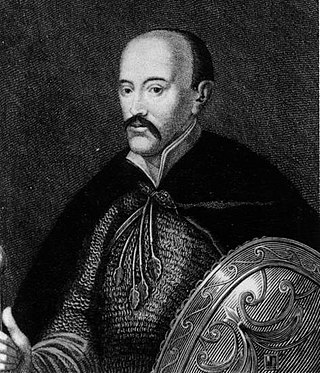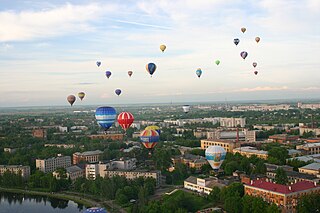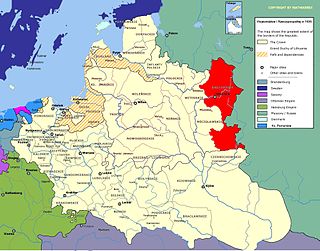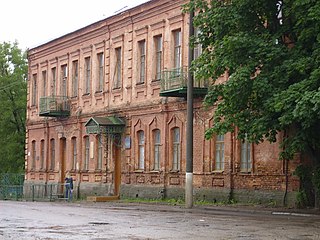
Stephen Báthory was Voivode of Transylvania (1571–1576), Prince of Transylvania (1576–1586), as well as King of Poland and Grand Duke of Lithuania (1576–1586).

The Deluge was a series of mid-17th-century military campaigns in the Polish–Lithuanian Commonwealth. In a wider sense, it applies to the period between the Khmelnytsky Uprising of 1648 and the Truce of Andrusovo in 1667, comprising the Polish theatres of the Russo-Polish and Second Northern Wars. In a stricter sense, the term refers to the Swedish invasion and occupation of the Commonwealth as a theatre of the Second Northern War (1655–1660) only; in Poland and Lithuania this period is called the Swedish Deluge, or less commonly the Russo–Swedish Deluge due to the simultaneous Russo-Polish War. The term "deluge" was popularized by Henryk Sienkiewicz in his novel The Deluge (1886).

The Truce or Treaty of Yam-Zapolsky (Ям-Запольский) or Jam Zapolski, signed on 15 January 1582 between the Polish–Lithuanian Commonwealth and the Tsardom of Russia, was one of the treaties that ended the Livonian War. It followed the successful Livonian campaign of Stephen Báthory, culminating in the siege of Pskov.

The Livonian War (1558–1583) was fought for control of Old Livonia. The Tsardom of Russia faced a varying coalition of the Dano-Norwegian Realm, the Kingdom of Sweden, and the Union of the Grand Duchy of Lithuania and the Kingdom of Poland.

Aleksander Korwin Gosiewskide armis Ślepowron, was a Polish nobleman, military commander and diplomat, Lithuanian Field-Quartermaster since 1630, Palatine-Governor of Smolensk from 1625, Lithuanian Great-Quartermaster since 1615, Speaker of the Parliament in 1613, Great-Secretary of the Grand Duchy of Lithuania from 1610 and District-Governor of Wieliż, Puńsk, Kupise, Biel, and Markowa.

Velikiye Luki is a town in Pskov Oblast, Russia, located on the meandering Lovat River. It is the second largest town in Pskov Oblast; population: 86,711 (2021 Census); 98,778 (2010 Census); 104,979 (2002 Census); 113,745 (1989 Soviet census). Velikiye Luki is a City of Military Glory, an honor bestowed on it because of the courage and heroism its citizens displayed during World War II.

The Smolensk War (1632–1634) was a conflict fought between the Polish–Lithuanian Commonwealth and Russia.

The siege of Pskov, known as the Pskov Defense in Russia, took place between August 1581 and February 1582, when the army of the Polish king and Grand Duke of Lithuania Stephen Báthory laid an unsuccessful siege and successful blockade of the city of Pskov during the final stage of the Livonian War of 1558–1583.

Nevel is a town and the administrative center of Nevelsky District in Pskov Oblast, Russia, located on Lake Nevel 242 kilometers (150 mi) southeast of Pskov, the administrative center of the oblast. Population: 16,324 (2010 Census); 18,545 (2002 Census); 22,472 (1989 Soviet census).

Sebezh is a town and the administrative center of Sebezhsky District in Pskov Oblast, Russia, located in a picturesque setting between Lakes Sebezhskoye and Orono 189 kilometers (117 mi) south of Pskov, the administrative center of the oblast. Population: 6,375 (2010 Census); 7,138 (2002 Census); 9,497 (1989 Soviet census).

The Polish–Swedish War (1600–1611) was a continuation of struggle between Sweden and the Polish–Lithuanian Commonwealth over control of Livonia and Estonia, as well as the dispute over the Swedish throne between Charles IX of Sweden and Sigismund III of Poland. After skirmishes, sieges and battles often aborted by Jan Karol Chodkiewicz, a truce was signed until the later invasion by the Russians.

The Polish–Swedish War of 1621 to 1625 was a war in a long-running series of conflicts between the Polish–Lithuanian Commonwealth and the Swedish Empire. It began with a Swedish invasion of the Polish–Lithuanian fiefdom Livonia. Swedish forces succeeded in taking the city of Riga after a siege. The Commonwealth, focused on a war with the Ottoman Empire, was unable to send significant forces to stop Gustav Adolf, and signed a truce favorable to Sweden. The Commonwealth ceded Livonia north of the Dvina (Düna) river, and retained only nominal control over Riga. The new truce in Mitau was signed and lasted from November 1622 to March 1625.
The Muscovite–Lithuanian Wars were a series of wars between the Grand Duchy of Lithuania, allied with the Kingdom of Poland, and the Grand Duchy of Moscow, which was later unified with other Russian principalities to eventually become the Tsardom of Russia. After several defeats at the hands of Ivan III and Vasily III, the Lithuanians were increasingly reliant on Polish aid, which eventually became an important factor in the creation of the Polish–Lithuanian Commonwealth. Before the first series of wars in the 15th century, the Grand Duchy of Lithuania controlled vast stretches of Eastern European land, from Kiev to Mozhaysk, following the collapse of Kievan Rus' after the Mongol invasions. Over the course of the wars, particularly in the 16th century, the Muscovites expanded their domain westwards, taking control of many principalities.

Zamość Fortress is a set of fortifications constructed together with the city of Zamość. It was built between 1579 and 1618, and the construction was initiated by Chancellor and Hetman Jan Zamoyski. It was one of the biggest fortresses of the Polish–Lithuanian Commonwealth, built so solidly that it was able to resist the attacks of both the Cossacks and the Swedes during the Deluge. It was taken down in 1866, although fragments survive.

The Polish–Ottoman War of 1672–1676 was fought by the Polish–Lithuanian Commonwealth and the Ottoman Empire. It ended with the Treaty of Żurawno, by which the Commonwealth ceded control of most of its territories in Central Ukraine to the Ottomans. It was a prelude to the Great Turkish War.

The Livonian campaign of Stephen Báthory took place in the final stage of the Livonian War, between 1577 and 1582. Polish–Lithuanian forces led by Stephen Báthory successfully fought against the army of Russian tsar Ivan IV over the Duchy of Livonia and Polotsk. Russian forces were expelled from Livonia before the campaign was concluded by the Truce of Jam Zapolski.

Sebezhsky District is an administrative and municipal district (raion), one of the twenty-four in Pskov Oblast, Russia. It is located in the southwest of the oblast and borders Rasony and Verkhnyadzvinsk Districts of Vitebsk Oblast, Belarus to the south; Zilupe, Ludza, and Cibla municipalities of Latvia to the west; Krasnogorodsky and Opochetsky Districts to the north; and Pustoshkinsky and Nevelsky Districts to the east. The area of the district is 3,100 square kilometers (1,200 sq mi). Its administrative center is the town of Sebezh.

Usvyaty is an urban locality and the administrative center of Usvyatsky District of Pskov Oblast, Russia. It is located on the right bank of the Usvyacha River, between Lake Uzmen and Lake Usvyaty, two biggest lakes in the area. Municipally, it is incorporated as Usvyaty Urban Settlement, the only urban settlement in the district. Population: 2,961 (2010 Census); 3,148 (2002 Census); 3,638 (1989 Soviet census).
The siege of Belaya was the final military episode of the Smolensk War. The defense of the fortress by its small Russian garrison against a large Polish-Lithuanian army of King Władysław IV Vasa thwarted the king's plan to march against Moscow and made him sign the Treaty of Polyanovka in which he relinquished his claims to the Russian throne.

The siege of Polotsk was a siege by forces of the Polish–Lithuanian Commonwealth under Stefan Bathory on the Russian-held city of Polotsk. Polotsk had been captured and heavily fortified by the Russians under Ivan the Terrible in 1563 because the river Dwina, which led to the key city of Riga, flowed through it. Hungarian soldiers, led by Caspar Bekes, Polish soldiers, led by Mikolaj Mielecki, and Lithuanian soldiers, led by Mikolaj Radziwill, converged at the Dzisna fortress, joined Bathory's men, and moved on to Polotsk, with a total force of about 42,000. Polotsk had three fortresses: the central one, nearby Strelec fortress, and the walled town of Zapolochie. The primary focus was on the central fortress: first with artillery, which failed because it only punctured the wooden walls, then with cannons, and eventually with fire. The Russians defended Polotsk with trenches and artillery, but after the Hungarian contingent captured Zapolochie, the Russians surrendered. After taking the city, Bathory's forces then moved to besiege Velikiye Luki.


















